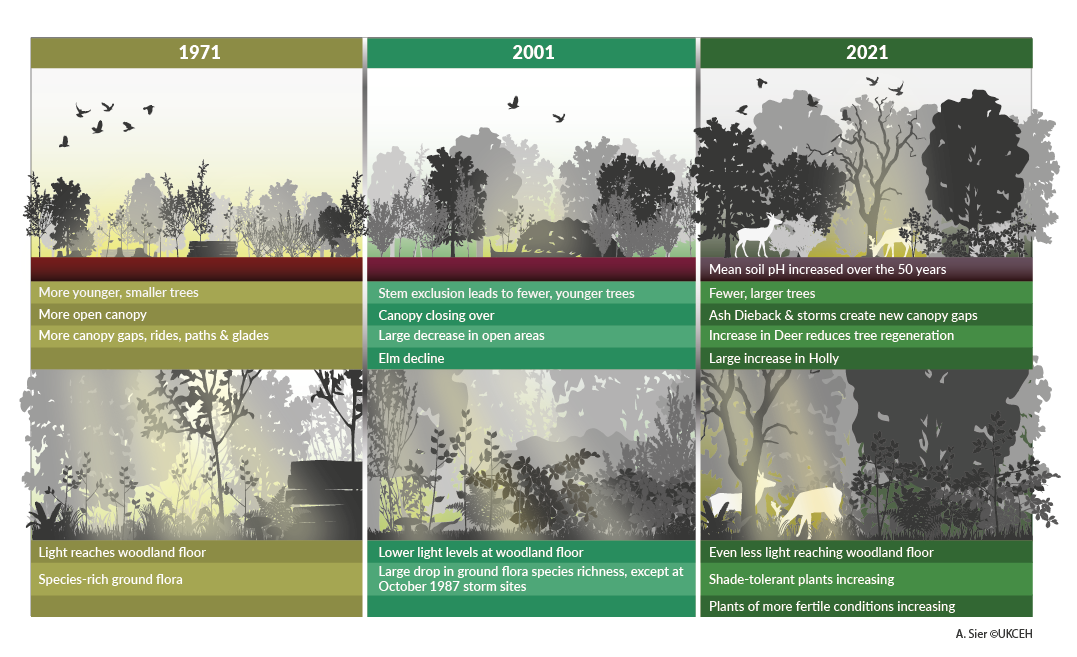Fascinating detailed surveys by the UK Centre for Ecology & Hydrology (UKCEH) have captured how Britain’s broadleaf woodlands have changed dramatically over the past 50 years, due to disease, lack of management, climate change and an increase in deer numbers.
Initially undertaken in 1971 by the late Professor Bob Bunce was repeated in 2001 and in 2021, the survey examines around 100 broadleaf woodlands in different landscapes across Britain.
A new UKCEH report looks at the data from that latest survey, commissioned by the Woodland Trust, and the changes compared to the previous two studies.
The surveys provide a unique and valuable resource for investigating the causes and consequences of change in woodland species composition and structure during a period of unprecedented environmental change.
The findings include:
- Woods are shadier due to a lack of management over time, with fewer canopy gaps, resulting in woodland composed of fewer but older and larger trees.
- Some species have increased and others decreased, though the overall species diversity in the surveyed plots has reduced by 22%.
- Shade-tolerant plants on the forest floor that have done well include bluebells, which have increased in occurrence by 15%.
- Species that have decreased in occurrence include those that support pollinators such as wood sorrel, birds-foot trefoil and thyme.
- The rise in minimum winter temperatures has led to an increase in holly by 16%, meaning it is now more common than hawthorn and beech in broadleaf woods.
UKCEH ecologist Dr Simon Smart, who led the latest survey, says: “The results strikingly suggest that many woodlands are now strongly impacted by factors such as herbivore grazing, climate change, extreme weather and tree disease against a backdrop of long-term reductions in deliberate management.”

Cycles of coppicing and the harvesting of mature timber planting can create a diverse woodland that provides opportunities for a wide range of species. But Dr Smart explains there has been a reduction in management due to the reduced economic viability of broadleaved woodland management and difficulty accessing funding and expertise.
In 1971 and 2001, none of plots surveyed showed signs of ash dieback but in 2021, some 21% of plots were affected by the disease.
Similarly, there was a massive increase in signs of Dutch Elm Disease in 2001 compared to 1971, and the latest study showed woodlands continue to be severely affected.
The latest survey also showed evidence that deer were eating vegetation across virtually many plots, consistent with ongoing year-on-year rises in their numbers across the country. This prevents woodland regeneration.
Further information
Professor Bob Bunce worked for Nature Conservancy and then the Institute of Terrestrial Ecology, a forerunner of UKCEH. He started the GB Woodland Survey in 1971 and founded the Countryside Survey, Britain’s first national survey of vegetation and the environment, in 1978. Professor Bunce was a Fellow of UKCEH after he retired and died in 2022.
The latest Bunce project was commissioned by the Woodland Trust, with significant financial contributions from players of People’s Postcode Lottery, the David Family Foundation, Welsh Government, Defra and Natural England, and smaller contributions from charitable trusts and individuals.
Useful links:
- Our Counting the Earth podcast on woodlands
- The report, Fifty years of change across British broadleaved woodland
- Bunce Woodland Survey project page.
- Survey data are available free via the EIDC portal.